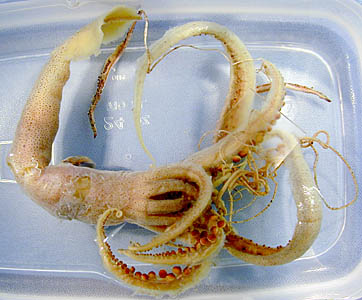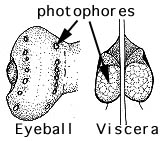Oh my goodness! Unless you are a Tree of Life developer,
you really shouldn't be here. This page is part of our beta test site, where we
develop new features for the ToL, often messing up a thing or two in the
process. Please visit the official version of this page, which is available
here.
Chiroteuthis spoeli Holotype Description Continued
Richard E. Young and Clyde F. E. Roper

Click on an image to view larger version & data in a new window

Figure. Dorsal view of the holotype of C. spoeli. Photograph by R. Young.
- Photophores
- Eyeball- Two series: lateral series (7 organs) = 1+5+1; medial series (seven organs) = 1+5+1.
- Viscera: two, large photophores.
- Club-tip photophore small, with papilla.
- One embedded in aboral surface of club at or just distal to proximal end of club (opposite trabecula 1 or 2).

Click on an image to view larger version & data in a new window


Figure. Photophores of C. spoeli. Left - Ventral view of occular photophores. Middle - Ventral view of the visceral photophores. Right - Aboral view of club-tip photophore. Drawings from Salcedo-Vargas (1996).
- Pigmentation
- Distal photophore with chromatophores only.
- Proximal and middle sections of club with epithelial pigment but absent on oral surface of distal section while present on aboral surface in proximal half.
- Club sucker stalks with epithelial pigmentation and strongly pleated.
- Buccal membrane unpigmented.
- Olfactory organ with chromatophores on stalk and head.
- Arms
- Arms I 51-59% of ML
- Arms III 107-117% of ML
- Arms IV 178-194% 0f ML
- Largest arm III suckers with 8-14 broad, rounded teeth, fused laterally; more distal suckers with thin blunt teeth; more proximal suckers with broader, rounded teeth.
- Largest suckers globular.

Click on an image to view larger version & data in a new window


Figure. Suckers of C. spoeli. Left - Oral-distal view of a large arm III sucker, holotype. Photograph by R. Young. Middle - Oral view of large arm III sucker. Right - Oral view of a club sucker. Drawings from Salcedo-Vargas (1996).
- Tentacular clubs
- Club length 47-71% of ML
- Suckers with 5-7 pointed teeth over distal half of ring; no enlarged central tooth.
- Sucker stalks- two distinct parts; stalks of lateral and medial suckers about equal in length.

Click on an image to view larger version & data in a new window

Figure. Oral view of tentacular sucker and stalk of C. spoeli. Drawing from Salcedo-Vargas (1996).
- Protective membranes
- Membranes in three distinctive sets with intermediate set broadest.
- Proximal set with ca. 18-19 slender, separate trabeculae (about 25% of club length).
- Intermediate set without distinct trabeculae (forms fleshy membrane) but opposite ca. 16 rows of suckers (about 35% of CL).
- Distal set with slender, separate, trabeculae opposite 23 rows of suckers (about 35% of CL).

Click on an image to view larger version & data in a new window

Figure. Oral view of the tentacular club of C. spoeli. Drawing from Salcedo-Vargas (1996).
- Head
- Head length 48-50% of ML.
- Funnel
- Funnel-locking apparatus with broad, protruding tragus and broad, well-developed antitragus; both overhang.

Click on an image to view larger version & data in a new window

Figure. Frontal view of the funnel locking-apparatus of C. spoeli. Drawing from Salcedo-Vargas (1996).
Comments
Description is from Salcedo-Vargas (1996) and re-examination of the holotype. Clubs of the holotype are stretched and distorted; counts of trabeculae are approximate.
References
Salcedo-Vargas, M. A. 1996. Cephalopods from the Netherlands Indian Ocean Programme (NIOP) - I. Chiroteuthis spoeli, n. spec. and Chiroteuthis picteti somaliensis n. subspec. Beaufortia, 46: 11-26.
About This Page

University of Hawaii, Honolulu, HI, USA

Smithsonian Institution, Washington, D. C., USA
Page copyright © 1999 and
 Page: Tree of Life
Chiroteuthis spoeli Holotype Description Continued
Authored by
Richard E. Young and Clyde F. E. Roper.
The TEXT of this page is licensed under the
Creative Commons Attribution-NonCommercial License - Version 3.0. Note that images and other media
featured on this page are each governed by their own license, and they may or may not be available
for reuse. Click on an image or a media link to access the media data window, which provides the
relevant licensing information. For the general terms and conditions of ToL material reuse and
redistribution, please see the Tree of Life Copyright
Policies.
Page: Tree of Life
Chiroteuthis spoeli Holotype Description Continued
Authored by
Richard E. Young and Clyde F. E. Roper.
The TEXT of this page is licensed under the
Creative Commons Attribution-NonCommercial License - Version 3.0. Note that images and other media
featured on this page are each governed by their own license, and they may or may not be available
for reuse. Click on an image or a media link to access the media data window, which provides the
relevant licensing information. For the general terms and conditions of ToL material reuse and
redistribution, please see the Tree of Life Copyright
Policies.











 Go to quick links
Go to quick search
Go to navigation for this section of the ToL site
Go to detailed links for the ToL site
Go to quick links
Go to quick search
Go to navigation for this section of the ToL site
Go to detailed links for the ToL site